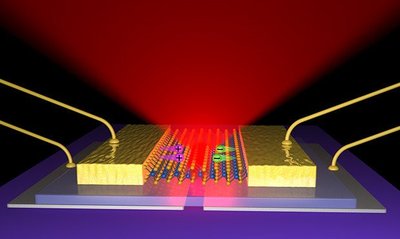Thinnest-ever LED created
US scientists have achieved an LED milestone, creating the thinnest LED yet.
The LED is based on two-dimensional flexible semiconductors, making it possible to stack or use in much smaller and more diverse applications than current technology allows.
“We are able to make the thinnest-possible LEDs - only three atoms thick, yet mechanically strong. Such thin and foldable LEDs are critical for future portable and integrated electronic devices,” said Xiaodong Xu, a University of Washington (UW) assistant professor in materials science and engineering and in physics.
Xu, along with Jason Ross, a UW materials science and engineering graduate student, co-authored a paper about this technology that appeared online in Nature Nanotechnology.

Most consumer electronics use three-dimensional LEDs, but these are 10 to 20 times thicker than the LEDs being developed by UW.
“These are 10,000 times smaller than the thickness of a human hair, yet the light they emit can be seen by standard measurement equipment,” Ross said. “This is a huge leap of miniaturisation of technology, and because it’s a semiconductor, you can do almost everything with it that is possible with existing, three-dimensional silicon technologies.”
UW’s LED is made from flat sheets of the molecular semiconductor known as tungsten diselenide, a member of a group of two-dimensional materials that have been recently identified as the thinnest-known semiconductors. Researchers use regular adhesive tape to extract a single sheet of this material from thick, layered pieces in a method inspired by the 2010 Nobel Prize in Physics awarded to the University of Manchester for isolating one-atom-thick flakes of carbon, called graphene, from a piece of graphite.
In addition to light-emitting applications, this technology could open doors for using light as interconnects to run nano-scale computer chips instead of standard devices that operate off the movement of electrons, or electricity. The latter process creates a lot of heat and wastes power, whereas sending light through a chip to achieve the same purpose would be highly efficient.
“A promising solution is to replace the electrical interconnect with optical ones, which will maintain the high bandwidth but consume less energy,” Xu said. “Our work makes it possible to make highly integrated and energy-efficient devices in areas such as lighting, optical communication and nano lasers.”
The research team is working on more efficient ways to create these thin LEDs and looking at what happens when two-dimensional materials are stacked in different ways. Additionally, these materials have been shown to react with polarised light in new ways that no other materials can, and researchers also will continue to pursue those applications.
New facility to boost homegrown solar PV manufacturing
A major solar module manufacturing facility is due to be developed in the NSW Hunter Valley,...
SA's Davenport BESS changes hands
AMPYR Australia has formed an agreement with Green Gold Energy to acquire the Davenport battery...
Partnership to streamline smart lighting infrastructure
A collaboration between Australian and US companies is set to expand the rollout of smart...




